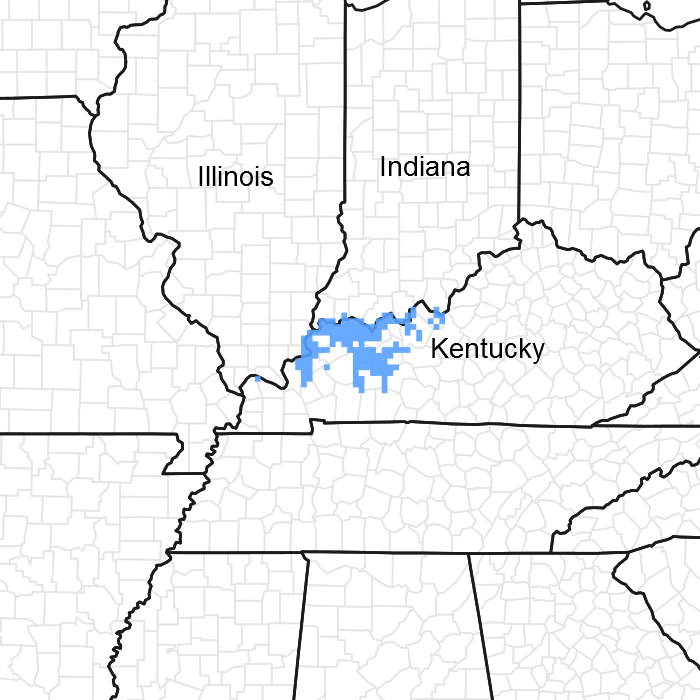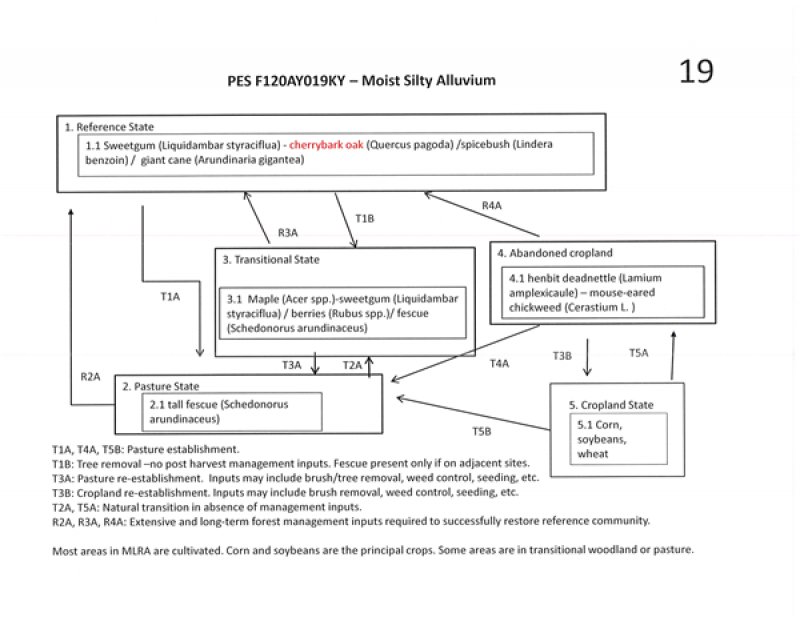
Natural Resources
Conservation Service
Ecological site F120AY019KY
Moist Silty Alluvium
Last updated: 10/01/2024
Accessed: 12/19/2025
General information
Provisional. A provisional ecological site description has undergone quality control and quality assurance review. It contains a working state and transition model and enough information to identify the ecological site.

Figure 1. Mapped extent
Areas shown in blue indicate the maximum mapped extent of this ecological site. Other ecological sites likely occur within the highlighted areas. It is also possible for this ecological site to occur outside of highlighted areas if detailed soil survey has not been completed or recently updated.
MLRA notes
Major Land Resource Area (MLRA): 120A–Kentucky and Indiana Sandstone and Shale Hills and Valleys, Southern Part
120B-Kentucky and Indiana Sandstone and Shale Hills and Valleys, Northwestern Part is located in Indiana and covers about 3,040 sq.mi. This area is in the Highland Rim Section of the Interior Low Plateaus Province of the Interior Plains. Tributaries of the Ohio River dissect the uplands. The major streams and rivers have well defined valleys with broad flood plains and numerous stream terraces. The geologic materials in this area are of Early and Middle Pennsylvanian and Late Mississippian age. The rocks consist mainly of flat-lying, interbedded sandstone, shale, coal, and siltstone with minor areas of limestone. Bedrock outcrops are common on river bluffs. The dominant soil orders in this MLRA are Alfisols, Ultisols, and Inceptisols. The soils in the area have a mesic soil temperature regime, a udic or aquic soil moisture regime, and dominantly mixed mineralogy. They formed dominantly in less than 40 inches of loess and in residuum or colluvium derived from sandstone, shale, and siltstone. The soils range from moderately deep to very deep and from poorly drained to somewhat excessively drained and are loamy, silty, or clayey. Fragiudalfs (Apalona, Zanesville) and Hapludalfs (Wellston) are the dominant soils on ridgetops and upper slopes. Hapludults (Adyeville) and Dystrudepts (Tipsaw) are on side slopes, and Hapludults (Tulip) are on footslopes. Hapludalfs (Deuchars, Ebal, Kitterman) are on structural benches and scarps. Endoaquepts (Zipp), Epiaqualfs (McGary), and Hapludalfs (Shircliff, Markland) are formed in lacustrine sediments. Hapludults (Millstone), Hapludalfs (Elkinsville), Fragiudalfs (Sciotoville), and Epiaqualfs (Hatfield) are on terraces along the Ohio River. Hapludolls (Huntington), Eutrudepts (McAdoo, Lindside), and Endoaquepts (Newark) are on flood plains along the major streams. Dystrudepts (Cuba, Steff), Eutrudepts (Gatchel, Haymond), Endoaquepts (Belknap, Stendal), and Fluvaquents (Birds, Bonnie) are on local flood plains.
Classification relationships
Bottomland Hardwood Forest ((Natural Communities of Kentucky, 2009. Kentucky State Nature Preserve Commission.)
Ecological site concept
The Moist Silty Alluvium ecological site occurs in moderately well drained to somewhat poorly drained floodplains along rivers and streams. Representative soils include: Belknap, Collins, Dupo, Lindside, Newark, Sharon, Steff, Stendal, Wakeland, Wilbur.
The communities described in this provisional document reflect plant communities that are likely to be found on these soils and have not been field verified. This PES describes hypotheses based on available data of many different scales and sources and has not been developed utilizing site-specific ecological field monitoring. This PES does not encompass the entire complexity or diversity of these sites. Field studies would be required to develop a comprehensive and science-based restoration plan for these sites.
State 1, Phase 1.1: Forestland.
Plant species dominant:
Sweetgum (Liquidambar styraciflua) - cherrybark oak (Quercus pagoda) /spicebush (Lindera benzoin) / giant cane (Arundinaria gigantea)
State 2, Phase 2.1: Pastureland.
Plant species dominant:
Schedonorus arundinaceus (tall fescue). Species present are dependent upon seeding and management.
State: 3. Phase 3.1: Transitional (Abandoned Field)
Plant species dominant:
Maple (Acer spp.)-sweetgum (Liquidambar styraciflua) / berries (Rubus spp.)/ fescue (Schedonorus arundinaceus)
This phase is best described as an old field habitat with a mixture of native and introduced grasses and a variety of native and non-native herbs, forbs, seedlings, and saplings. Species will depend on seed sources and ongoing disturbance levels.
State 4, Phase 4.1: Abandoned Cropland
Plant species dominant:
henbit deadnettle (Lamium amplexicaule) – mouse-eared chickweed (Cerastium L. )
Abandonment of cropland would result in many weed species taking over the site. Initially, annual weeds would be predominate followed by grasses, shrubs and pioneers trees.
State 5, Phase 5.1: Cropland.
Plant species dominants: dependent upon seeding and management.
Most common crops are corn and soybeans.
Restoration of states 2-5 to the reference community would require long-term, intensive management inputs.
Associated sites
| F120AY017KY |
Well Drained Silty Alluvium Well Drained Silty Alluvium |
|---|
Table 1. Dominant plant species
| Tree |
(1) Liquidambar styraciflua |
|---|---|
| Shrub |
(1) Lindera benzoin |
| Herbaceous |
(1) Carex |
Click on box and path labels to scroll to the respective text.
